Valleys and hillsides glowing golden under a beaming mid-summer sun, balmy breezes adding movement to trees and crops, are signatures of Berks’ beautiful seasonal landscape.
For those with roots and sentiments that extend beyond the county borders, these images harken the mind and spirit to other locales, some far across oceans.
Roberto and Amber Campitelli are among those. Both have strong familial Italian roots – Roberto’s in Ascoli Piceno and Amber’s in Naples and Sicily.
“We’re both 100 percent Italian,” Amber declares proudly.
They have an especial love of Tuscany, that central Italian paradise of ancient art, vineyards and culinary delights that captivates its locals and international tourists alike, and which has become the focus of literary bestsellers and Hollywood blockbusters.
While the Campitellis might not be living under the Tuscan sun, they’ve nonetheless managed to bring its luminescence to their home and its glorious gardens on a verdant Cumru Township hillside.
The welcoming sign “Villa Tuscana” offers a hint as to what’s in store, but it surely doesn’t tell the full story. Roberto and Amber fill in those blanks with a magnificent manor that showcases their characters and their heritage.
The couple and their four children were looking for a larger home in 2008 when they came across the 20-acre bank-owned property that sat vacant for two years. While the reality of the first impression of the large house and overgrown grounds left a lot to be desired, the potential it offered on that beautiful May day of its showing was inspirational.
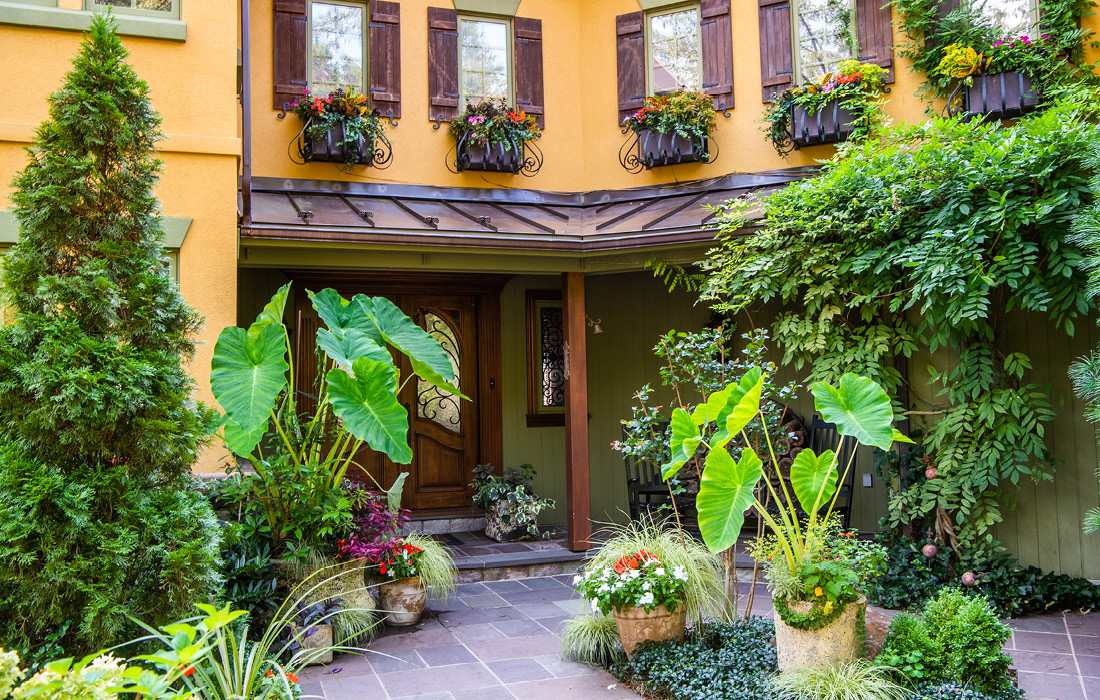
“Bones” and Blossoms
“It had the bones,” says Roberto. “We were enticed by the architecture of the building and the land.”
And the many varieties of shrubs and trees in full blossom added to the appeal.
For Amber, an overgrown wisteria was the clincher – and a sign.
“In our first house and our second house, the wisteria was still climbing, not really reaching where I’d have liked it to be,” she says. “Roberto built a pergola for it at our second house and as soon it was nearing the top, we decided to move. As soon as we saw the wisteria over the garage here, I knew we were home.”
Fourteen years later, the Campitellis are living the Tuscan dream right here in Berks. Getting there took time, planning, hard work and patience.
The exterior of the expansive house had been painted white; its architectural details overlooked.
“It had an Italian villa flair,” says Amber, “so we worked with that and painted the walls deep gold and the trim dark green. We added a bunch of wrought iron accents as well.”
When it came to sorting out the plantings, of which some like the Japanese lilacs and the umbrella pine were clearly carefully selected by the prior owners, the Campitellis called on renowned Berks professional landscaper Bruce Dingeldein.
They knew Dingeldein from his landscaping work at their business. “We asked him if he’d come to the house and handle the landscaping,” Amber recalls. “He said no, but that he would offer some pointers.”
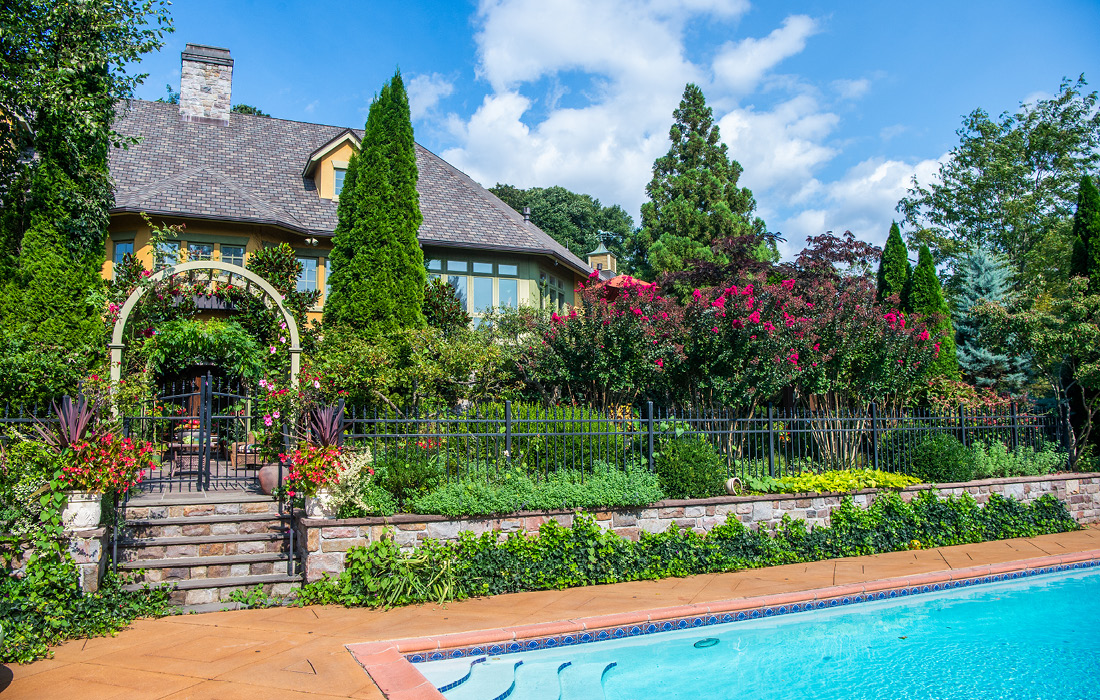
Days with Dingeldein
The appointment was made, but the couple was a bit late in arriving home.
“By the time we got home, Bruce had done almost all the pruning,” Roberto says, “and he took on the job. What’s nice about Bruce is that he has the artist’s eye. He’ll literally put something down and view it from every angle before planting it and continuing on.”
In addition to designing the garden areas to the front, rear and sides of the house, Dingeldein also designed the hardscapes for the patios as well as the stone-bordered graveled and grass pathways, the driveway and its circular island in front of the house. In the circle, Dingeldein and the Campitellis placed sunken pots to highlight their flowering plants.
“Bruce used the fieldstone native to the region for those borders,” says Roberto.
Dingeldein had a four-tier scalloped fountain anchored as the focal point of the rear garden.
Unique statuary and other intriguing artifacts and sculptures scattered through the garden areas are often discoveries of Dingeldein on his flea market, yard sale and antiquing forays.
“He’ll find something and send us a picture to see if we’d like it,” says Amber.
The Campitellis are passionate about selecting their plants, often with additional advice from Amber’s horticulturalist stepfather who was especially impressed with the property’s rare 60-foot umbrella pine.
As there were so many – in quality and quantity – perennials on the land, the couple looks for annuals that will add color, particularly when the perennials aren’t in bloom.
“I like pinks, blues, yellows, oranges,” says Amber. “Although he might not think all the colors go with the house, he plants them anyway.”
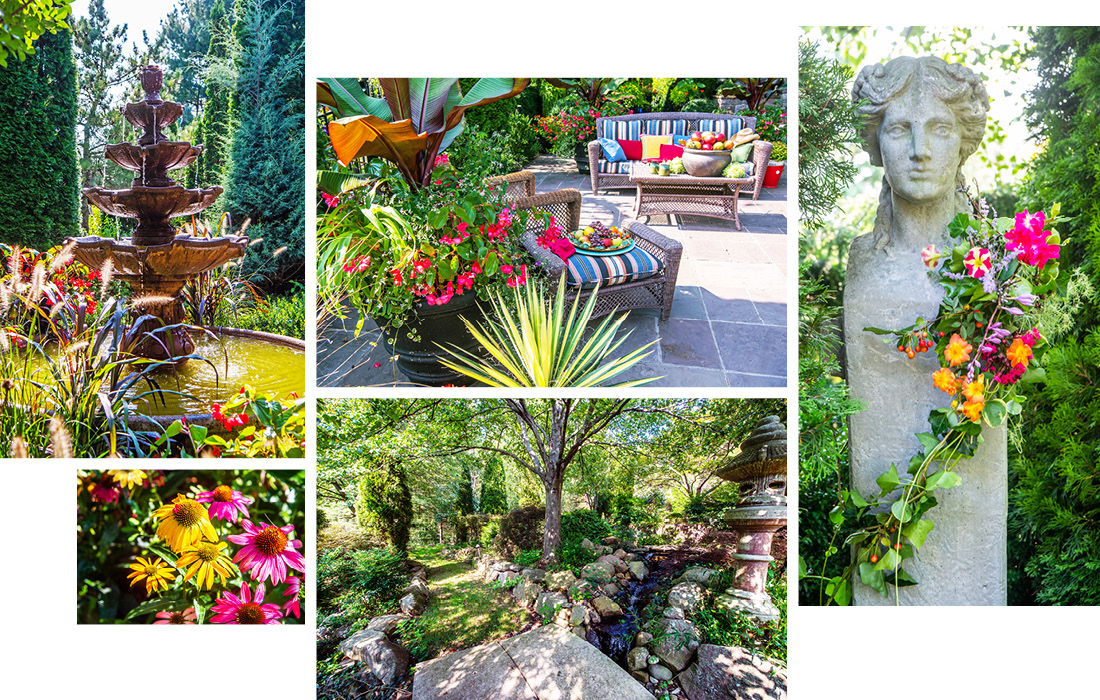
Gardens Galore
Indeed, in this time at the height of summer, the word “lush” is an understatement when it comes to describing the four key garden areas of Villa Tuscana.
From lobelia and delphinium, both prized for their blazing blues, to varieties of begonias and coleus to multi-color impatiens and dusty millers, to elephant ears, fountain grass, caladium, flax and huge canna lillies, the many containers and planting areas are bursting with color. Ferns occupy the containers fronting the garage. Boxwoods are also part of the mix.
The pool, surrounded by a wrought iron fence and tiered planting borders, is approached from the house via a flowering vine-covered arched pergola. Plants and flowers cascade from carefully placed containers with cushy rattan furnishings nearby.
The house boasts a number of window boxes. A particularly large one spanning the breadth of four second-story windows is filled with black-eyed Susans. At the same level, single boxes spill torrents of flowers in hues of red, yellow and orange complemented by Spanish Cedar wood shutters.
And vines…everywhere there are vines because the Campitellis love them best. There is ivy, dense bougainvillea, trumpet vines, and, of course, wisteria, all growing, spilling and cavorting along and over buildings and making a stroll under a fine pergola even more enchanting.
Clematis abounds, but one color is Amber and Roberto’s sentimental favorite. “Sweet Autumn Clematis was in full bloom the day we got married,” says Amber. The couple will celebrate their 23rd anniversary next month.
The cost of flowers, especially when planting hundreds of them, clearly adds up. The Campitellis decided to cut into those costs by growing their own plants from seeds.
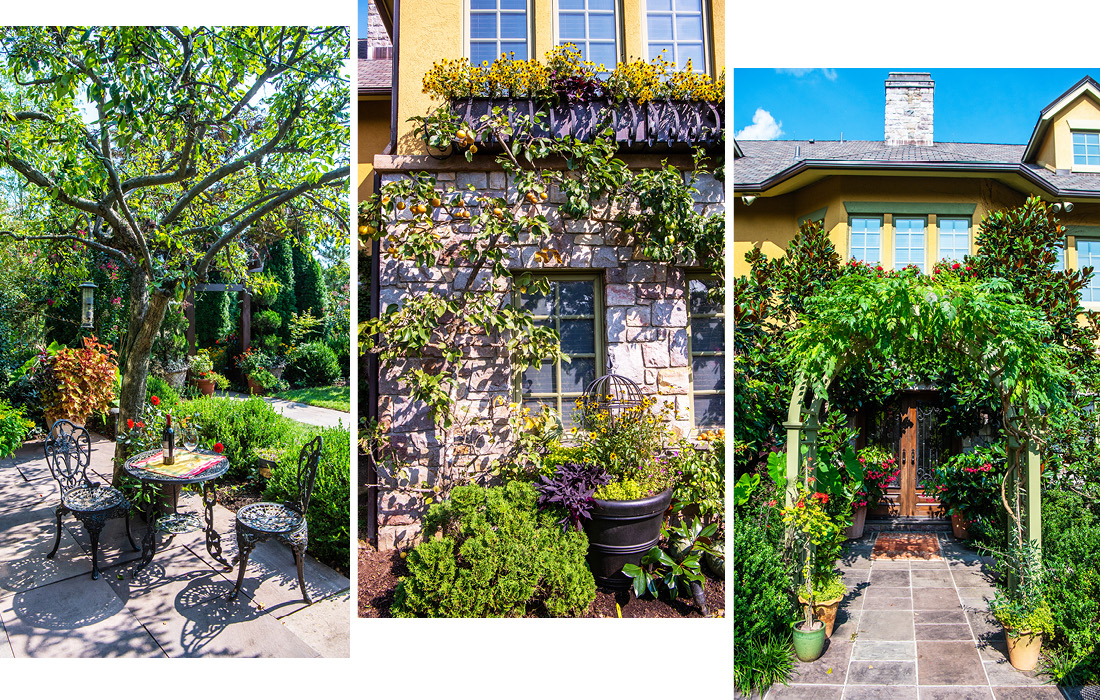
Animal Interests
So, in the past year, they built an eight-by-20-foot greenhouse near the barn where it captures the most sun.
“It went up last fall, and I’m in it every day,” says Roberto.
The family’s entire vegetable garden was started by seeds. Indeed, as early as late May, some of the tomato plants were already producing ripening fruit.
“In the long term, we will be saving a lot of money,” says Amber.
The greenhouse shelters the lemon and fig trees that are moved outdoors in the spring. Roberto’s father, from whom he says he inherited his green thumb, gifted them.
During the couple’s recent vacation to Italy, their four children ranging from school age to young adults, made sure the plants were watered and the family pets cared for.
Among the “pets” are: 15 goats, some sheep, 18 chickens and five cats (three barn cats and two indoor habitants). The chickens provide between three and four dozen eggs a week.
“My mom and Roberto’s parents enjoy them,” says Amber.
“Yes,” laughed Roberto, “my dad comes and steals the eggs!”
More than those eggs get “stolen.” Along with the domesticated animals, there is also an abundance of wildlife. Deer, foxes, chipmunks and squirrels are all around. And, the deer, in particular, seem to have an affinity for tulip bulbs.
Birds find feeders and perches throughout the property, including safe havens in the bosoms of some of the Italian cypress trees, also known as Mediterranean or Tuscan cypress. This variety of tall thin cypresses are the well-known hallmarks of the Tuscan landscape, lining that area’s roadways and fields.
Favoring a more domestic setting is a cardinal that makes its presence known daily by pecking on a window. Amber likes to believe it’s a little bird she saved that’s now grown and that its visits are proof it’s doing just fine.
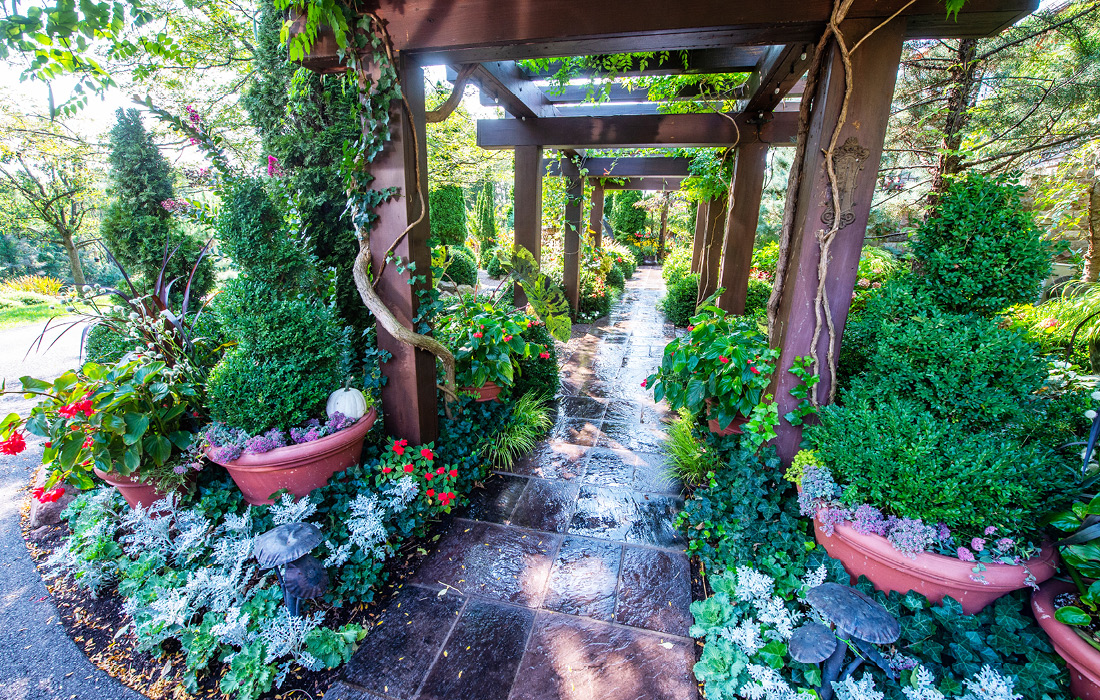
Busy Bees
The couple recently took up beekeeping, setting up three hives now home to Italian and Carniolan honey bees critical to the pollination of a span of fruit trees.
Each of the winding pathways around the house and beyond provide their own journeys. And, those pathways linking the gardens can reveal smaller nooks, including one with a wrought-iron bistro table and chairs, the perfect setting for a shared bottle of summer wine.
While sitting there sipping the late afternoon away, one might hear the sound of a trickling waterfall. Indeed, a small one is positioned close to the koi pond to the rear of the house, and it’s a family favorite.
Amber admits to not keeping lots of plants in the house, but those she does favor include succulents and herbs like rosemary.
She does cultivate orchids in her light-filled office.
“I have seven or eight and one is always blooming,” she says. “I keep them in the same spot and water them once a week or even every other week. I think it’s interesting that when I bring in a new orchid, the older ones kick in (with blooms). I believe it’s the pheromones – the plants feel each other.”
While the Campitellis’ property boasts full mature landscaping, both urge others to do as they did: just get started.
“What I would say is don’t be afraid of taking that first step,” says Amber. “Start with a small section. At our first home, I took a little area and created some beauty. Here in Pennsylvania, the weather is pretty ideal – lots of sun and rain. The garden will take off quickly, and you’ll have beauty all season long.”
Roberto concurs.
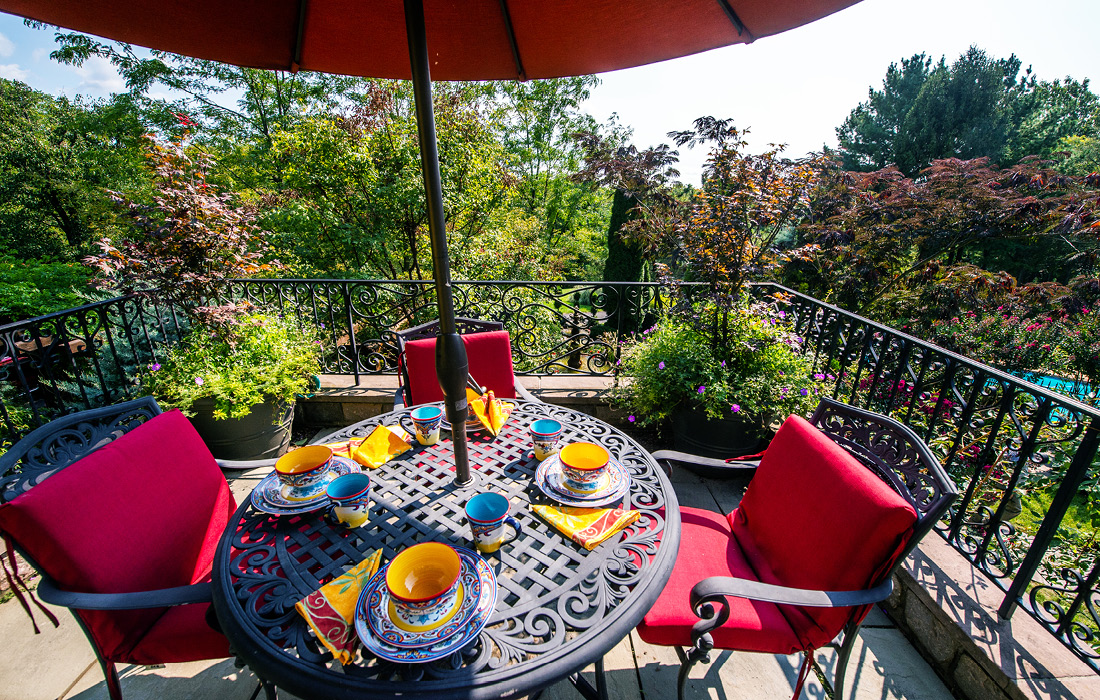
“It’s a feeling of accomplishment, really,” he says, “and it’s so nice when people stop by and take notice.”
He also believes that the influence of HGTV – of which he is a fan – as well as the stay-at-home year of COVID increased interest in home gardening. A shared interest and collaboration between spouses is another plus.
“In our case, I’m the gardener, and she’s the one planting and designing, and it works out very well.”















